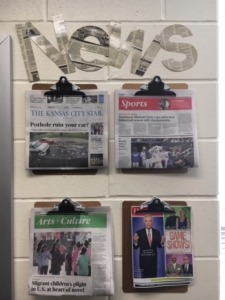Check out my post on Edutopia!
Ask any ELA teacher to tell you some of the main challenges of the job, and a likely answer is keeping up with responding to student writing. It’s a laborious task, yet we know it’s a significant part of helping student writers. In fact, no writer improves without two things: lots and lots of practice, and helpful feedback.
Yet a secondary teacher who has anywhere from 100 to 180 students cannot provide as much effective feedback as they would like to provide. So many of us turn to peer feedback to help.
From my experience, peer feedback works best when students are with writing partners/groups for a chunk of time. Building trust must happen before students can provide good feedback, and more importantly, before they will accept feedback from other students.
Just like any other structure, the success of peer feedback rests on clear expectations and modeling of both the “right” and “wrong” way. The first time I expect students to provide feedback in a school year, I like to ask volunteers to fishbowl an example. I pull the volunteers into the hall while I ask the remaining students to work with their groups to create descriptions of what they expect a good peer conference to look like. I work quickly with the volunteer group to create a brief example of a bad conference. Honestly, it usually goes beyond bad to truly terrible!

As you might guess, this fishbowl results in a lot of laughs, but it also creates an entry point to talk about negative behaviors. After the laughs subside, we debrief and create a list of all the bad behaviors and a class chart of what should happen instead.
Then it’s time to practice. Like with any other practice, I walk the room, listening in on groups and making notes of points and behaviors to highlight. Students love to be highlighted in positive ways, and I reinforce my expectations through these positive highlights – a win-win!
In addition to behavior expectations, I also use protocols to provide structure and language so all students can find success.
Here are a few of my favorite protocols.
Best Line and Three Questions: Peers find a “best line” in the piece, and they share why they chose this line in discussion. Then they ask three genuine questions. Students may need a mini-lesson on generating helpful questions, and all students will need you to model this protocol, maybe several times, before they will be able to do it well.
If students are not quite ready for Best Line, perhaps start with this sentence stem protocol: I noticed (positive) . . . , and as a reader, I would like . . . .
PQP – Praise, Question, Polish: This protocol is widely used, and you can find many versions online. This works well with older or more experienced students. Most teachers provide a few sentence stems for each of the three feedback categories, so I listed some below.
Praise: Identify the strengths of the piece.
- “My favorite part is … because …”
- “… was effective because …”
- “You were really clear about …”
- “As a reader, I particularly enjoyed …”
Question: Dig into both the structure and the content of the piece. Cross reference the writing with the assignment and/or rubric.
- “Could you help me to see … better?”
- “Would you consider adding (taking out, changing) … in order to …?”
- “What if you moved this word or phrase? (Provide thinking for the move.)
- “I’m not sure I understand this part clearly; (then provide specific question)”
Polish: Look at the “big picture” to consider the writing as a whole. What should the writer focus his/her attention on to add the final touches to the piece?
- Have you considered …?
- Could you add more to … in order to …?
- What do you want your readers to think, do, or believe when they are finished reading your piece?
- If you made this structural revision [define], your readers would ….
For younger students, use My Turn, Your Turn. You model a specific feedback statement, like a “best line” that includes figurative language, and then instruct all students to find a best line with figurative language. Be sure to model with academic language.
There are many, many protocols to help you guide students as they provide peer feedback, and in helping each other, they become critical readers and develop strong “read like a writer” skills. Done well, days spent providing peer feedback are powerful learning days!
Now that students have ideas, it’s time to flesh out the stories.
With any piece of writing, two parts are critical for students: ideas and organization. Both of these, known to many teachers as traits of writing, can be difficult for any writer. Who hasn’t labored over a first rough draft, trying hard to find a way to pull it together? Writing is hard work, so it’s no wonder students find ways to avoid it sometimes.
When you are ready for students to dig in and write a piece of fiction (or any other piece of writing), it’s important to think about what writers need. I know I need time – time to think, time to experiment, time to get feedback, time to re-examine mentor texts, time to rewrite, and time to read my work out loud.
That’s a lot of time, especially since teachers are constantly battling the clock.
The only way I know to provide students with enough time and support is to utilize a workshop structure in the classroom. If you need a quick overview on workshop structure, check out this blog post from Two Writing Teachers. Workshop provides students in-class time for all the critical parts writing, including time to confer with me and with peers, rather than setting the expectation that students will write outside of class time without support.
After spending some writing workshop time on thinking, drafting, and conferring, students are ready for narrowing their focus and “reading like a writer” again, but with a specific lens. To limit this activity, I ask students to read their mentor texts for the following: character, suspense, and conflict. High school students can handle working on all three, but for middle school students, I would suggest letting them choose one, or one at a time at least.
To provide some structure, I pose a few questions such as these:
- Character: What character trait is most important about the main character? How does the writer reveal it in the story? How do this character’s actions move the plot?
- Suspense: Where does the writer build tension in the story? How did he/she build this tension for the reader? Why does it work?
- Conflict: What is blocking the character from getting what s/he wants? Does this conflict escalate/complicate as the story progresses? Does this conflict come from outside and inside?
Students spend time working alone, reading and annotating. Then students meet with their writing group, or you can re-group students by the mentor text or element they chose to analyze.
All students work on the question “What did you learn about characterization, suspense, and/or conflict that you want to try in your writing?”
I think this is an important question on which to spend a little whole-class time debriefing. Students can benefit from hearing which techniques other writers prioritized and ways students discuss the elements of fiction. Clearly, students are developing their reading skills throughout this lesson series, and listening to what other students notice is a low stakes way of developing students’ knowledge of and ability to analyze text.
Armed with ideas and techniques, it’s back to writing time. Younger students may be adding on to their quickwrite, while more skilled or older students should be deep into their drafts.
Within a workshop schedule, time to write, confer, and revise continues for days. I try to have copies of mentor texts available around the room so students can get “professional” help without waiting for me.
Students are also always working on reading goals – always.
Our classroom expectation is this: If you are stuck during writing time, switch to reading. Of course, this was something I dedicated time to at the beginning of the school year, defining and modeling expectations, and even so, I would sometimes need to pull a student to have a behavior conference instead of a writing conference.

For students who come to class without their independent reading books, I always have plenty of books of all genres around the room. Sometimes, though, students do not want to dive into a new book, so I borrowed a wonderful strategy from my colleague Whitney Keeton. Whitney provides newspaper stories she thinks students might be interested in, and students are able to pick an article, read it, and put it back before they leave the classroom. Yes, sometimes a student simply wants to read how a favorite sports team fared the night before, but the student is still reading!
If I notice a student chooses to read rather than to write several days in a row, I make sure to confer with that student. It could be that the student prefers to write at home. Or it could be that the student is stuck and needs my help to move forward with the writing. Reluctant writers sometimes need short, specific writing goals for each day, so that might be worth posting each day. The best determiners of success are making sure students are interested in what they are writing and feel secure in the classroom community. If these two things are in place, I have successful writing workshop days!
Next, students use protocols to provide feedback to each other.
It’s that time of year — the dreaded preparation time for state assessments!
Over my career, many folks told me “Just don’t worry about it.” The reality for a classroom teacher is we have an obligation to our students, to their parents/guardians, and to the other stakeholders of our communities to do what we can to prepare students both academically and emotionally.
I am a parent and a community stakeholder, too, you see, and as such, I support measures for reducing the number of tests, I participate in writing and evaluating assessment questions, and I advocate for kids always. But if students will be tested, I will help them prepare.
Although most tests are a combination of reading and writing (and a few other topics), I am going to zoom in on writing for this post.
In recent years, as we approached review time, I would lead a book chat on the Divergent. Most of my students have read the series, but there were always a few who were not familiar with the story. Then students would line up and draw for their “faction,” an idea I stole from colleague Mindy Bishop years ago. Throughout test review time, usually two weeks, students sat with their factions, and each day, I presented the factions a challenge. Often students had to work individually on the task first, but I built in a collaborative element to each challenge. As a team, the factions scored points every day. (These were not grades or points for the gradebook.) Setting up the review in this way made it fun, and honestly, the students put more effort that usual into each task.
I recently heard from Mindy, and here’s her new spin on making assessment review fun: “I called it March MAP Madness. The kids were different college basketball teams from the tournament, and the different MAP prep activities scored them points for their teams. It was a huge hit with the kids. The championship team from each hour “won” a pizza lunch with me. They worked so hard to be the winner. I just love middle schoolers!”
To review for an on-demand writing assessment, I usually start with prompt analysis. If students cannot determine exactly what they are being asked to do, they cannot be successful. Some questions for prompt analysis include the following:
- What exactly is the prompt asking me to address in my answer?
- How many tasks are listed in the prompt?
- In what format should the answer be?
- How should I support my answer?
- How will my answer be evaluated?
- What process should I go through to accomplish this writing task?
While I model with a true prompt, one way to add fun is to ask students to devise silly, overly complicated prompts. Then they trade, do a prompt analysis, and share their results with the class. Be ready to laugh during the sharing part!
Next, I remind students not to skip prewriting. For most of us, the most difficult part of writing is simply gathering ideas and starting. Students can go into all-out panic mode just looking at the blank writing space! If you have been utilizing strategies such as Writing into the Day with quickwrites, your students only need a gentle reminder of tools in their toolbox, such as
- Quickwrite strategies for prewriting
- Protocols and reading strategies to approach prompts and articles
- Habits of mind to “enter the conversation” and to think about all perspectives
For tests, I think the most powerful strategy is the writing sprint. If students have practiced writing quickly from a word, picture, or simple prompt, they can utilize this strategy to get their thoughts started on the topic, and the simple act of stream-of-consciousness writing may calm their nerves.
As a way to practice without simply asking each student to write an essay, I often ask students to spend 10-20 quiet minutes writing ideas for answering a prompt, followed by time to share and discuss. Then students collaborate on an outline or draft, depending on time. Another approach is to ask everyone to write a quick draft, and then the group creates one draft, incorporating parts from everyone’s quick draft. The real benefit to these strategies is the conversation and negotiations the students have with each other as they work together.
Another activity I used many times was to provide students with student essays I had saved from previous years. Students highlighted parts they felt were successful in one color and unsuccessful in another color. Then they wrote feedback based on the checklist and/or rubric that would be used for the assessment. Usually the students were more critical than I was when I provided feedback!
If you need practice prompts, I have written two Missouri examples and linked them here:
http://tinyurl.com/EOC-sample-2019
https://tinyurl.com/SampleMAP2019
The MAP prompt is argumentative. (In Missouri, the EOC is a high school assessment, and the MAP is a middle school assessment.)
An important point to note is that some students need strategies for calming anxiety even after you have provided them with all they need to be successful. I found that having a conference to talk through the strategies students might use to calm the anxiety was worthwhile. It didn’t take away the anxiety, but the students knew I supported them and would be pulling for them on test day, and that’s worth something.
Want more ideas? See this work from the Plymouth Writing Project!
Good luck to everyone, teachers and students alike!
Follow my blog with Bloglovin
“It must be a piece of writing which, even if someone else reads it, doesn’t send any ripples back to you. It is like writing something and putting it in a bottle in the sea. . . . Freewritings help you by providing no feedback at all. ” Peter Elbow, 1973
“A quickwrite is a first draft response to a short piece of writing . . . . This is writing to find writing, but using someone else’s words to stimulate their thinking.” Linda Rief, 2018
Now comes the fun part – gathering ideas for writing!
Every writer can struggle to get started. Sometimes our commitments demand all of our attention. Sometimes our worries crowd out every other idea or thought. For many of us, our inner critic smashes down every inkling of an idea before it blossoms.
If all writers struggle, how does a teacher get a classroom full of students to write at the same time ? Quickwriting!
I first learned of this concept from Peter Elbow’s work. I was a new teacher at the time, and Elbow’s “freewriting” not only made sense for use with my students, but also helped me with my own writing through college. Freewriting as Elbow defines it is writing without stopping for a designated length of time. Then the writer chooses an idea from the freewriting and writes again. The goal is to keep going no matter what, even if you repeat a word or phrase over and over until a new idea comes.
In recent years, I’ve heard educators use terms such as “writing sprints” or “quickwrites.” Writing sprints increased in popularity alongside NaNoWiMo’s climb into the education world, and writers can even join a writing community of sprinters through Twitter ( See @NaNoWordSprints )Linda Rief uses the term quickwrite to combine mentor text models with writing ideas quickly as she described in her book The Quickwrite Handbook: 100 Mentor Texts to Jumpstart Your Students’ Thinking and Writing. Lots of educators, including me, use the term “quickwrite” to refer to a variation of freewriting and writing sprints.
All variations of a quickwrite have a few key qualities in common. They all
- Increase the amount writing in the classroom
- Help the writer focus on ideas without critique, either by an inner voice or the teacher
- Increase fluency over time
- Help writers of all ages find success, even enjoyment, in writing
- Utilize little class time
- Provide starting points for writing conferences
For our flash fiction unit, I used a variation that focuses the writer on brainstorming for a particular writing task. Although I altered the quickwrite prompt each year, here is an example:
Choose one of the following settings (or one of your own) and build the picture by focusing on imagery: What do you see? hear? smell? feel? taste?
- a real or imagined classroom
- night time in a woods (or city!)
- a childhood bedroom
- distant relative’s house
- an abandoned car on an embankment of a stream
- a setting of your choosing

My classroom routine for quickwrites looks like this:
- After I share the prompt and students have written the date in the quickwrites section of their notebook, students have a couple of quiet minutes for thinking. Then everyone, including me, writes for three minutes without stopping. I volley between writing and “kidwatching” to notice who might be struggling or to note someone to give a shout out to for their work.
- I quietly tell students when they have 30 seconds remaining. At the end of 30 seconds, I ask students to stop without finishing the sentence they are working on. If they know they want to come back to this piece, they can put ellipses.
- Everyone tallies their word count and writes it in the margin next to today’s quickwrite. I ask students to give me a thumbs up if their word count is at least 5 more words than their previous word count, a “thumbs to the side” if their word count is plus or minus 5 words, and a thumbs down if their word count is 5 or more fewer words than their previous word count. I make it clear that everyone is working on fluency at his or her own pace.
- Depending upon the goals for the day’s lesson, students might do a two-minute share with a shoulder partner, a few whole-group show of hands for who wrote to which choice, or a whole-group workshop session if a writer wanted to share his or her piece to get advice for next steps.
This routine is something I introduced every year, no matter which grade level I was teaching that year, in the first few days of school, and the classes practiced with high-engagement prompts until everyone knew the routine.
Yes, there were usually students who tried to avoid writing by writing “I don’t know what to write” over and over for the full three minutes, but that often stopped without my intervention. Students quickly realized how boring it was to write the same thing over and over, or they realized all writing was celebrated and none of it was perfect. If we were a week into the routine and the avoidance behaviors were still in place, it was time for a one-on-one conference to find out why and to do what I could to take away the student’s fear of writing.
For this assignment, I often chose a whole-group show of hands to get a sense of which settings appealed to each class, and then students shared with a writing partner. The partner’s job was to ask questions so the writer could continue to think about how the setting could be developed. We spent about 10 minutes of partner time, so this lesson was not a whole class period.
Next, students go back to a mentor text to read like a writer with a purpose.
A few years ago, my best friend Penny gave me Year of Yes: How to Dance It Out, Stand in the Sun and Be Your Own Person by Shonda Rhimes. Penny and I have been faithful followers of Grey’s Anatomy since it first aired, so she knew I would enjoy learning a bit of Shonda’s story.
The book details a year in Shonda’s life that stems from a discussion with her oldest sister at Thanksgiving in 2013, a discussion that centers on one statement:
“You never say yes to anything.”
Shonda describes how this statement created a pivotal moment in her life. The statement sticks with her until it wakes her up in the middle of the night several weeks later.
What follows is an inner monologue in which Shonda reveals her introverted nature, and as I was reading it, I was struck by how her words could have flowed from many students in my classroom that year. She has a revelation at the end of the monologue, and admits she is unhappy, even though she doesn’t feel she is “allowed” to be unhappy. This was another feeling I knew several students in my class held inside. As the title suggests, she commits to saying yes to as much as possible for an entire year to address her sister’s statement.
I decided to use this story as an after-holiday-break quickwrite. I shared some of the information in story form, and I read a couple of key pieces out loud, making sure to pick classroom-appropriate sections. Then I asked the students to reflect on what they could “say yes” to in their lives to help them reach a goal or generate more happiness. We all wrote for three minutes, and then for another three minutes, since no one was ready to stop when the usual length of time was up.
A few students were willing to share out loud, but most said their writing was too personal, and I respected that. Many said how much they enjoyed writing this quickwrite, and a few even said they were going to add more later. I transitioned to a discussion on stream-of-consciousness as a stylistic choice, and we had a fun first day back from break.
What struck me most about this experience was the way students kept bringing it up over the next few weeks. Some would come up to me in the hall to say they had been “saying yes” more often. Other said they told their parents about the writing and their parents offered to help them reach their goals. One girl asked if she could meet with me in private, and she shared her realization that she had not been very kind to a few other girls in the class because she felt inferior to them without cause. My goal had been to ease into a new semester with something I thought students might enjoy, and I had not anticipated the depth of their response to the assignment. I vowed to weave in more reflective quickwrites.

This kind of reflective journaling is not new, but some of the research about it is. In a recent New York Times article “What’s All This About Journaling?” noted the resurgence of reflective writing:
Once the domain of teenage girls and the literati, journaling has become a hallmark of the so-called self-care movement, right up there with meditation. And for good reason: Scientific studies have shown it to be essentially a panacea for modern life. There are the obvious benefits, like a boost in mindfulness, memory and communication skills. But studies have also found that writing in a journal can lead to better sleep, a stronger immune system, more self-confidence and a higher I.Q.
With all of these benefits and the current focus on trauma-informed teaching, reflective journaling is worth fitting into your curriculum if you have the option. I used my students’ positive reactions as my motivation to keep this as a first-day-back-from-break activity from that year on, and now I’m sharing it with you. Enjoy, and Happy New Year!
Remember assistant principal Richard Vernon from The Breakfast Club? Who could forget his hostile approach to supervising adolescents during a Saturday detention! We would like to think his character is more caricature than realistic, but versions of Richard Vernon seem to haunt most schools, and of course, as a new teacher, you will want to avoid being sucked in by them.
Instead, find your tribe. Teaching can be as emotionally draining as it is fulfilling, and you will need your tribe to help you along the way.
I have been fortunate enough to find many, many people in my tribe over my teaching career. My very first department chair became my career mentor, and we still get together. When we do, we talk passionately about education, books, previous students we run into, and we still lose track of time.
One of my interdisciplinary teams became a strong support system for the day-to-day stresses. Anyone who needed to talk through an issue would email the group to email and ask to “meet on the square.” The carpet pattern created a blue square in a spot in the middle of a hallway, and we would stand in a tight circle on that square to listen, to support, and to offer suggestions if the person asked.
My district committed to long-term relationships with consultants, and two became mentors for me: Ruth Culham and Ellin Keene.
Ruth and I bonded over our love of YA literature and writing. We got to know each other waiting in a long line for the final Harry Potter book. What a night! My seventh grade daughter was with us, and she still talks about that night. Ruth used some of her experiences visiting my classroom in her book Traits of Writing: The Complete Guide for Middle School, which required monthly conversations and sharing of stories — such fun! She invited me to contribute to Using Benchmark Papers to Teach Writing with the Traits, which pushed me way out of my comfort zone and created my interest in sharing lesson ideas.
Ellin came to our district to help us grow as reading teachers and to guide our curriculum revision. We spent many long hours together on these tasks, and her quick wit and talent with students made every minute enjoyable. She worked with me and a team of teachers to develop an in-house lab system of professional development, which was the best PD model I experienced in my career. It remains a topic I am passionate about. She suggested many times that I write a book, and that’s a current goal.
Find mentors that push you to grow.
My main tribe consists of all the talented, intelligent ELA teachers I worked with through the years. Members of both my high school and middle ELA departments became friends both at school and in life, and they still fill my soul with joy over shared interests and passions. Some of them are pictured above.
How will you know if someone should be in your tribe?
This seems like an easy question, right? Most likely, you will be assigned a mentor. Other people who are nice, friendly, and welcoming will probably approach you. Teachers in your hall or who have the same lunch shift will definitely want to share stories with you. So how do you know whom to gravitate toward?
Pay close attention to the words people use when describing the students in their classroom. While all of us have students who try our patience or who frustrate us, we have many, many more students who delight and amaze us. Teachers who never seem to share their happy moments will probably make the job harder than it needs to be, so avoid spending your precious time listening to constant griping. According to Raj Raghunathan Ph.D., “Constant exposure to such negativity can make deep inroads into your bank of positivity, leading you to . . .become negative—diffident, anxious, and distrustful—yourself . . . .”
Look for teachers whose philosophies and pedagogy aligns at least somewhat with yours. While you are still growing your knowledge base, you have a sense of what feels right as you try different ideas. Be true to those feelings. I almost quit teaching in the first few years because I tried to teach exactly like another teacher, and it did not work for me. Students know when you are aligning your practice with your beliefs, and they will know when you are not!
Trust your gut. Unfortunately, many people feed off of dragging others down. Some teachers are so afraid of change that they attach themselves quickly to newcomers so they can ensure the new folks won’t initiate change. Many people equate change with loss, as Zachary Herrmann discusses in his blog post The Challenge of Change, so it’s not a surprise that this reaction is one you can find in most schools. Listen to your gut feelings about a person’s motives for befriending you. Those feelings will generally be correct!
Passion is contagious. Teaching is a career that is as much a calling as it is a skill, so you probably became a teacher because you felt passionate about education, literacy, children, etc. When you talk about what you love, don’t be afraid to let your passion show. We all get excited when we find others who love what we love, and that shared passion will forge a natural bond.
So find your tribe, and then nurture the people in your tribe. You will be able to withstand the pressures and stresses of teaching if you stand together in joy with other teachers.
After students practice reading like a writer to create anchor charts for elements of flash fiction, it’s time to apply their learning to new texts. Again, I like providing several text selections so students have choice, but this time, I give students a very brief text chat, a shorter version of a book talk, and let them come to the table and choose the story they want to read. I am sure to include information on text complexity, such as a setting that flashes back and forth in time. Sometimes this challenges students to try a more complex text; other times students choose a safe, easier text structure. Regardless of their choices, all students hear information about text complexity in an authentic way, and over time, they start to articulate ways in which a text is complex, too.
As students settle in to their text selections, I instruct them to annotate for the elements on our class anchor chart. Some sample questions to focus their work might include the following:
- Which elements are present in this new text?
- How effectively does this author use each element in comparison to your previous text?
- What new information do you notice with this text?
This is an excellent time to walk around with a clipboard and make notes of students who seem to be struggling or who have naïve misconceptions about the elements or structure of fiction. During independent work time, I ask these students to join an invitational group to review and to shore up their understanding.
When they have finished reading and annotating, students discuss their findings with their table group. (If you have enough time, students could meet with other students who read the same text to discuss first. If the stories are good, students will want to talk about them!) They each share what they noticed with their new text, and as a group, they decide whether anything should be added, changed, or deleted from the anchor chart.
Why do I spend a whole extra class period reading a second text and continuing work on an anchor chart?
The first day students bring their schema to the task, and until they have time to discuss, they do not have new learning. By the time they read the second text, most have added at least one or two new ideas or more complex ways of looking at structure to their schema, so their experience reading the second text is richer. Some will hear the same information a second time, but their understanding of that information is clearer and potentially more nuanced.
In the next blog post, students deepen their understanding of these structural elements again as they begin to apply their learning in writing.
A few years ago, our state standards added fiction (Why fiction?) under the narrative mode strands, and in my roles as ELA teacher and instructional coach, I began a hunt for lesson ideas, resources, and research to share with my ELA team. After all, for most of my career, teaching students to write fiction was limited to creative writing classes. I felt out of my element.
And then I discovered the world of flash fiction.
At the time, I did not find much information from any of my go-to PD professionals, nor did I find much in the way of research. But I did find an overwhelming number of sites that promoted and published flash fiction, including student flash fiction. These sites also offered tips and reviews, and I knew that’s all I really needed.
I dedicated our first class of the unit to immersing students in flash fiction. For some genre studies, I advocate for total discovery, allowing students to search online and in print, but because many of the flash fiction sites are targeted to adult readers, I pulled grade-appropriate examples for my students.
My students were already familiar with the protocols for “reading like a writer,” so I did not need to model the general strategy. I piled several selections on the center of each group’s desks, and they started by simply reading the piece they chose. Some students annotated; others chose not to annotate.
 Since each person in a table group read a different selection, students regrouped all around the room with other students who read the same text. I provided time for students to discuss and to ask questions, and then I directed students to “read like a writer with a focus ” while I listened in and guided groups as needed.
Since each person in a table group read a different selection, students regrouped all around the room with other students who read the same text. I provided time for students to discuss and to ask questions, and then I directed students to “read like a writer with a focus ” while I listened in and guided groups as needed.
Read like a writer with a focus takes on various purposes for me. In this stage of the lesson, the focus was to notice elements of flash fiction. In groups, students wrote notes of what they noticed in their sample flash fiction. Once students wrapped up capturing their thinking, they moved back to their table groups to share across several text examples, discussing similarities and differences.
I think this is an important step. I know many teachers limit this part of a “notice and note” lesson, to borrow a term from Kylene Beers and Robert Probst, by asking all students to use one model text. In this way, teachers ensure students focus on the elements they have predetermined as important. But I think one key to keeping students engaged is to allow for true discovery. If students know they are simply trying to “find” what the teacher wants them to find, the joy of the hunt disappears. Other teachers feel their students would be completely lost without a demonstration first. If you determine your students need to see you model the strategy first, definitely work that into the plan. See a model here. In my experience, though, if students have done this with any mode of writing, they are able to apply the strategy without a demo.
Another benefit to allowing students to discover elements of a genre themselves is the lesson is automatically differentiated for the students in each classroom. What students notice and articulate will reflect their current knowledge about the topic. This can help determine mini-lessons or small group instruction that each class needs.
Which leads me to another benefit – time.
Almost every literacy teacher I know feels the pressure of time; there’s never enough to do all that the students need. So why waste time presenting predetermined mini-lessons over basic information like elements of fiction or the structure of flash fiction?
Each table group then contributed to our class Elements of Flash Fiction chart. While there are many methods of creating a chart, my favorites always include time for students to get up and write on the chart (or multiple charts) themselves or to negotiate what I should write on the chart by using a strategy. One strategy I like is Four Corners. For this lesson, a group will throw out a strategy, and then students can move to the corner of the room to indicate how strongly they agree or disagree that the element is important enough to go on the chart. (The four corners are labeled strongly agree, agree, disagree, and strongly disagree).
The question in a secondary classroom is “How do I avoid ending up with 5-7 charts of the same information?” Sometimes I use all of the charts, switching them each class period, but I didn’t always want to have to remember to switch charts. One tactic I used with success is posting all of the charts the second day, and asking students to choose their top 4 per class period, and from these lists, I created one universal anchor chart. This is a wonderful way to review the information and to ask students to critically evaluate each idea at the same time.
Depending on your school’s class periods, this is either one or two class periods. I was fortunate to finish the class chart, but that’s all the time we had. If you have more time, you could ask students to reflect in their journals about what they discovered about flash fiction, what element they want to be sure to try when they write, or their main take-aways. If you prefer, students could jot one thing they learned about flash fiction and one question they have on an exit ticket. This would provide a quick check for understanding and provide a record of ideas for explicit mini-lessons.






